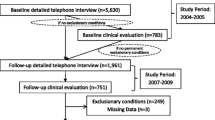Abstract
Objective: To study the prevalence of fatigue in the general population and its association with psychiatric disorders, somatization, and medical utilization.
Setting: The public-use data tape from the 1984 National Institute of Mental Health Epidemiologic Catchment Area Study.
Participants: Household sample of 18,571 subjects.
Interventions: Structured psychiatric interviews were reviewed to study the prevalences of complaints of current and lifetime fatigue and their relationship to selected psychiatric disorders.
Results: Fatigue has high current (6.7%) and lifetime (24.4%) prevalences in the general population. Medically unexplained fatigue also has high current (6.0%) and lifetime (15.5%) prevalences. When compared with those reporting no current fatigue, subjects who reported current (one-month) fatigue were significantly more likely to have experienced current and lifetime episodes of major depression, dysthymic disorder, panic disorder, and somatization disorder. They also had significantly higher mean numbers of lifetime and current DSM-HI psychiatric diagnoses, medically unexplained physical symptoms (not just fatigue-related symptoms), and visits to health care providers than did patients without current episodes of fatigue.
Conclusions: The high prevalence of fatigue in the general population appears to be significantly associated with increased lifetime and current risk for affective, anxiety, and somatoform disorders, as well as increased utilization of medical services. These data suggest that assessment of both medical and psychological health may be essential for the proper care of patients with fatigue.
Similar content being viewed by others
References
The National Ambulatory Care Survey. 1975 summary. Hyattsville, MD: National Center for Health Statistics, 1978;22–6.
Kroenke K, Wood DR, Mangelsdorff AD, Meier NJ, Powell JB. Chronic fatigue in primary care. Prevalence, patient characteristics, and outcome. JAMA. 1988;260:929–34.
Buchwald D, Sullivan JL, Komaroff A. Frequency of “chronic active Epstein-Barr virus infection” in a general medical practice. JAMA. 1987;257:2303–8.
The Health and Lifestyle Survey [British government study]. London: Health Promotion Research Trust, 1987.
Kroenke K, Mangelsdorff AD. Common symptoms in ambulatory care: incidence, evaluation, therapy, and outcome. Am J Med. 1989;86:262–6.
Katon WJ, Buchwald DS, Simon GE, Russo JE, Mease PJ. Psychiatric illness in patients with chronic fatigue and those with rheumatoid arthritis. J Gen Intern Med. 1991;6:277–85.
Taerk GS, Toner BB, Salit IE, Garfinkel PE, Ozersky S. Depression in patients with neuromyasthenia (benign myalgic encephalomyelitis). Int J Psychiatry Med. 1987;17:49–56.
Wessely S, Powell R. Fatigue syndromes: a comparison of chronic “postviral” fatigue with neuromuscular and affective disorders. 1989;52:940–8.
Kruesi MJP, Dale J, Straus SE. Psychiatric diagnoses in patients who have chronic fatigue syndrome. J Clin Psychiatry. 1989;50:53–6.
Manu P, Lane TJ, Matthews DA. The frequency of the chronic fatigue syndrome in patients with symptoms of persistent fatigue. Ann Intern Med. 1988;109:554–6.
Gold D, Bowden R, Sixbey J, et al. Chronic fatigue. A prospective clinical and virologic study. JAMA. 1990;264:48–53.
Wood GC, Bentall RP, Göpfert, Edwards RHT. A comparative psychiatric assessment of patients with chronic fatigue syndrome and muscle disease. Psychol Med. 1991;21:619–28.
Hickie I, Lloyd A, Wakefield D, Parker G. The psychiatric status of patients with the chronic fatigue syndrome. Br J Psychiatry. 1990;156:534–40.
Cathebras PJ, Robbins JM, Kirmayer LJ, Hayton BC: Fatigue in primary care: prevalence, psychiatric comorbidity, illness behavior, and outcome. J Gen Intern Med. 1992;7:276–86.
Holmes GP, Kaplan JE, Gantz NM, et al. Chronic fatigue syndrome: a working case definition. Ann Intern Med. 1988;103:387–9.
Regier DA, Myers JK, Kramer M, et al. The NIMH Epidemiologic Catchment Area program. Arch Gen Psychiatry. 1984;41:934–41.
Robins LN, Helzer JE, Croughan J, et al. National Institute of Health Diagnostic Interview Schedule. Arch Gen Psychiatry. 1981;38:381–9.
George LK, Holzer CE, Skinner EA, Works J, Timbers DM, Munson ML. Data preparation. In: Eaton WW, Kessler LG (eds). Epidemiologic Field Methods in Psychiatry. Orlando, FL: Academic Press, 1985;104.
Escobar JI, Burnham MA, Karno M, et al. Somatization in the community. Arch Gen Psychiatry. 1987;44:713–8.
Hannay D. Symptom prevalence in the community. J R Coll Gen Pract. 1978;28:492–9.
Chen M. The epidemiology of self-perceived fatigue among adults. Prev Med. 1986;15:74–81.
Cheng T. Symptomatology of minor psychiatric morbidity: a cross-cultural comparison. Psychol Med. 1989;19:697–708.
Hammond E. Some preliminary findings on physical complaints from a prospective survey of 1,064,004 men and women. Am J Public Health. 1964;54:11–23.
Smith GR. Somatization disorder in the medical setting. National Institute of Mental Health, 1990. Washington, DC: DHHS Pub. No. (ADM) 90-1631.
Katon WJ, Russo J. Chronic fatigue syndrome criteria: a critique of the requirement for multiple physical complaints. Arch Intern Med. 1992;152:1604–9.
Katon WJ, Walker EA. The relationship of chronic fatigue to psychiatric illness in community, primary care and tertiary care samples. Presented at CIBA Foundation Symposium on Chronic Fatigue Syndrome, London, May 1992.
Additional information
Received from the Department of Psychiatry and Behavioral Sciences, Division of Consultation-Liaison, RP-10, University of Washington, Seattle, Washington 98195.
Rights and permissions
About this article
Cite this article
Walker, E.A., Katon, W.J. & Jemelka, R.P. Psychiatric disorders and medical care utilization among people in the general population who report fatigue. J Gen Intern Med 8, 436–440 (1993). https://doi.org/10.1007/BF02599621
Issue Date:
DOI: https://doi.org/10.1007/BF02599621



